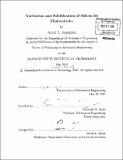Nucleation and solidification of silicon for photovoltaics
Author(s)
Appapillai, Anjuli T. (Anjuli Tara)
DownloadFull printable version (15.94Mb)
Other Contributors
Massachusetts Institute of Technology. Dept. of Mechanical Engineering.
Advisor
Emanuel M. Sachs.
Terms of use
Metadata
Show full item recordAbstract
The majority of solar cells produced today are made with crystalline silicon wafers, which are typically manufactured by growing a large piece of silicon and then sawing it into ~200 pm wafers, a process which converts one-half of the high-purity silicon into waste sawdust. To bypass the sawing process, a new method for making high-quality multicrystalline wafers without sawing is under development. This method begins with a poorly-structured silicon wafer made by a low-cost method which is then coated by a thin film capsule. The encapsulated wafer is zone-melted and recrystallized, thus improving the crystal structure for a higher-efficiency solar cell without material waste. This work develops the wafer recrystallization process by gaining insight on three major areas, motivated by the need to increase recrystallized grain size and control thermal gradients. First, a novel method for measuring the temperature field in the wafer within the high-temperature zone-melt furnace is designed and demonstrated. Knowledge of the temperature gradients experienced by the wafer is important to improve the furnace design to minimize the thermal stress and resulting dislocation density in the recrystallizing silicon. Secondly, a thermal model was created to determine the shape of the crystalmelt interface during recrystallization as a function of processing parameters such as wafer travel speed and thickness, because the orientation of the solidification interface dictates the direction of grain growth and the subsequent grain boundary orientation, which affects solar cell performance. A threshold wafer travel speed was found, above which the crystal-melt interface becomes non-planar and grain boundaries will form at the mid-wafer plane. Lastly, to evaluate different wafer capsule materials, nucleation behavior of molten silicon on various materials was studied through differential scanning calorimetry. The level of undercooling reached by molten silicon in contact with variations of silicon nitride and oxide was evaluated and the optimal capsule configuration was determined; this configuration was demonstrated to improve recrystallized wafer structure. These insights gained from this work will inform future design decisions in tailoring the crystal structure for optimal solar cell performance.
Description
Thesis (Ph. D.)--Massachusetts Institute of Technology, Dept. of Mechanical Engineering, 2010. Cataloged from PDF version of thesis. Includes bibliographical references.
Date issued
2010Department
Massachusetts Institute of Technology. Department of Mechanical EngineeringPublisher
Massachusetts Institute of Technology
Keywords
Mechanical Engineering.